Posts Tagged ‘Green’
Wednesday, April 2nd, 2014

Here in the U.S. the first day of Spring (the Vernal Equinox) came and went on March 20, 2014; not that anybody around here noticed. To me, the first day of Spring is the day of the Tigers Home Opener. This year it was March 31, 2014 and the weather co-operated with temperatures in the 60’s.
The four seasons as we know them here in the U.S. are the well known Spring, Summer Autumn (Fall) and Winter, each being three months long. The joke in Michigan is that we have only two seasons; Winter and Road Construction. To prove this point, the Michigan Department of Transportation has released its map of construction projects for 2014. As a child I always viewed Summer and Winter as being much longer than Spring and Autumn. I think this has to do with the fact that here in Michigan winter weather begins long before the first day of winter and that school lets out long before the first day of Summer. When I lived in Florida there seemed to only be two seasons: Tourist Season (November to March) and Summer (April to October). Summer was when all the Snowbirds left and I could get into my favorite restaruants without a long line. It was also the only time we went to the Beach.
A scientist in Australia recently suggested that they need more than the traditional four seasons. Dr. Tim Entwisle thinks we need to break Spring into two seasons; Sprinter (early Spring) and Sprummer (late Spring), giving us a total of five seasons. He claims that indigenous peoples in Australia have up to seven seasons based on plant and animal life as well as weather.
The Union of Concerned Scientist feel that due to global Climate Change Spring arrives 10 days earlier than it used to in the 1950’s. They go on to say that this “Spring Creep” leads to late Summer forest fires, droughts and floods.
Any way you look at it. Spring is here and I couldn’t be happier. We are gearing up for one of our seasons, Rain Barrel Seasons. Pop over to MIRainBarrel.com and take a look at the upcoming Rain Barrel Events we have scheduled.
Tags: Green, Spring
Posted in Blog, Latest News | No Comments »
Friday, October 5th, 2012

I have written before about the S.S. Badger, the last coal-fired ferry on Lake Michigan. (see my September 29, 2012 blog post. The EPA in 2008 gave the ships owners 4 years to comply with the Clean Water Act and stop dumping tons of coal ash into Lake Michigan. Instead of converting to diesel or some other fuel, the ship owners recently asked the EPA for a 5 year extension of their coal dumping permit citing the need to study a conversion to liquified natural gas. Now, they are stooping to greenwashing.
As reported by Dave Alexander at Mlive.com, the S. S. Badger has extended it’s sailing season to November 2, 2012, in order to ship parts for 60 wind turbines for G.E. The ferry owners claim that this is another reason why the EPA needs to extend their coal dumping permit allowing them to operate next year and beyond. Perhaps the irony of shipping wind turbine parts on the only coal fired ship on the Great Lakes, a ship that dumps tons of coal ash into Lake Michigan each year, is lost on Lake Michigan Carferry. However it is not lost on me and some other commentators.
No amount of greenwashing makes their failure to comply with the Clean Water Act, seeking landmark status, or other delaying tactics more palatable. As the Milwaukee Sentinel Journal stated in a recent editorial: Lake Michigan Carferry needs to find a way to keep the ferry running without adding more coal ash to the lake. This has been going on long enough. No one argues that coal-fired power plants should keep operating because the technology they use has a historic status. Pollution does not deserve protection.
I agree. No amount of greenwashing should save Lake Michigan Carferry and it’s S.S. Badger from having to comply with the same laws as its competitors. The coal ash dumping must stop at the end of this season. They can use the off season to convert to diesel or find a way to store the ash on board until they can safely unload it. Enough is enough.
What do you think about the S.S. Badger story, leave a comment below or carry it over to Twitter @MaxiContainer
Tags: Coal, Green, S.S. Badger
Posted in Blog, Latest News | No Comments »
Wednesday, August 8th, 2012

Recently, the recycling authority serving my hometown of Farmington Hills, MI, the RRRASOC – the Resource, Recovery and Recycling Authority of Southwest Oakland County, went to single stream recycling. Single stream recycling is a system in which all recyclables, including newspaper, cardboard, plastic, aluminum, junk mail, etc., are placed in a single bin or cart for recycling. These recyclables are collected by a single truck and taken to a Materials Recovery Facility (MRF) to be sorted into various commodity streams for sale to markets, where it is processed into feedstock which can be used in the manufacture of new products. Here is a picture of our new 96 gallon cart, which is 82 gallons larger than our old bin.
Until recently, the predominant form of curbside recycling in the U.S was “dual stream” collection where each material type is kept in a separate bag or bin, and trucks have three or more compartments. The move to single stream recycling is a way to reduce costs. On the collection side, the use of a large roll-cart allows collectors to automate pick-up from inside the truck cab, and single-compartment trucks save labor and transportation costs. (See, Single Stream Uncovered by Clarissa Morawski, Resource Recycling, Feb. 2010). Due to the ease of use and larger bin sizes, cities often see an increase in recycling rates. In areas where single stream recycling is offered, participation is around 95%. Ann Arbor, MI had a 20% increase in recycling tonnage after implementing single stream recycling in 2010. Unfortunately, that 20% increase was 40% short of projections and caused Recycle Ann Arbor to request an increase of over $107,000. Ann Arbor’s single stream recycling system cost over $4.6 million to implement and, based on the overly optimistic projections, was expected to take 7 years to repay the costs.
The real complaint against single stream recycling is an increase in contaminants, causing a decrease in value for the recycled materials and an increase in the amount of previously recycled materials going to landfills. The Blue Heron Paper Company saw the level of contamination go from 3.3% in 1999 to 6.1% in 2005. This caused them to send over 11,000 tons of material to landfills in 2005, up from 5,200 tons in 1999. However, by implementing a consumer education program and investing in new technology at the material recovery facility, the Metro Waste Facility in central Iowa was able to keep contaminant levels to 3%.
Michel E. Hoffman of Wunderlich Securities points out one of the other possible downsides of single stream recycling. He believes that the move to single-stream recycling could have consequences. Hoffman says, “There are a lot of small- and medium-sized companies that will have to think about building single-stream MRFs. Some won’t have access to capital. Those who do have capital may not want to risk it. The alternative would be to sell to a larger competitor. So as single-stream processing matures, it may fuel a new wave of consolidation in the waste industry.”
The recession of 2008 has led to reduced city budgets. This has only sped the adoption of single stream recycling due to its lower costs. With this pressure on government to reduce costs, despite its mixed success, despite increased contaminants and increased consolidation (leading to less competition) it looks like Single Stream recycling is here to stay.
Tags: Farmington, Farmington Hills, Green, Green LIving, Michigan, Recycling, Recycling Containers, single stream, sustainability
Posted in Blog, Latest News | No Comments »
Wednesday, July 4th, 2012

We are extremely busy this time of year, between all the green fairs and festivals, plus our workshops. Many weekends are surrendered to the cause of green living, reducing ones carbon footprint by installing a rain barrel.
After visiting California recently I started to realize that based on climate and water usage you may not need a rain barrel. Then I thought, well what would it hurt to have one anyone. And all I could come up with is that it couldn’t. There is almost no reason in my mind as to why you wouldn’t benefit from saving even just one barrel of water when you can save up enough rain. Then this all got me thinking about the many various uses for the extra water. Contrary to the many skeptics, rain barrels can be useful no matter who you are. The water can be used for many different uses, some of them are:
- Washing your car
- Washing your hair
- Watering House Plants
- Watering Outdoor Plants / Flowers
- Watering your lawn (using a Rain Barrel Pump)
- Reduce Stormwater Runoff
- Promote Rain Gardens and/or Ponds
- Washing the dog?
Let us know what you use your rain barrel for, leave us a comment below or Tweet us @MaxiContainer
***Under no circumstances do we recommend drinking rain water from your rain barrel. You don’t know whats on your roof… but Water Treatment tabs are handy to have and cheap… here’s a few on Amazon.com – keep them around in case of emergency, to turn your rain water into a drinkable source of water.
Tags: California, climate, Green, Green LIving, Michigan, rain barrels, Rain Water, summer
Posted in Blog, Latest News | No Comments »
Friday, May 18th, 2012
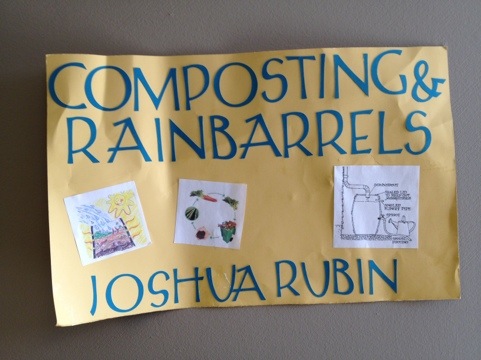
Recently I got the opportunity to be a special guest speaker at Johnson upper elementary thanks to Julie Thompson, leader of their PTA. One of my favorite things to do is talk to kids about water conservation, reuse, composting etc. The questions they ask are priceless and I also make sure to ask them a lot of questions too. In my day to day I forget sometimes what it was like in middle school. When your attend school dances and feel awkward and actually I “rebeled” as my parents would say, refusing to join any school teams but rather spend all my hours after (and sometimes during) school skateboarding. I still skateboard and it has given me a perspective that I would not otherwise know. When I arrive at the skatepark you have kids of all ages interacting it’s their park. Like it’s their park… This is our earth and we all have to take care of it. If we don’t teach kids the importance of green living then it will surely die. In a throw away society, water that just magically flows out the tap, soil which you buy at a store are winning. It’s time to change that, and change starts with the kids.
Tags: Composting, Green, Green LIving, rain barrels, schools, Water Conservation
Posted in Blog, Latest News | No Comments »
Monday, May 14th, 2012

Boy, have we been busy. Rain Barrel Season started early and the response has been overwhelming. On April 14, 2012 we partnered with the Sierra Club Great Lakes Program and the Detroit Riverfront Conservancy to host Rain Barrels on the Riverfront. Over 100 participants used Maxi Container’s Rain Barrel Kits to build their own Rain Barrels.
A week later, April 21 and 22, we were at the Grosse Pointe Live Green Fair, were our own Joshua Rubin was interviewed on Fox 2 News about our rain barrels. After the interview, people were waiting at our booth to purchase our repurposed rain barrels.
Upcoming events include, Chelsea Live Green Fair, May 19 and 20, Rochester Green Living Festival, June 22, 23, and 24, Wyandotte Green Live Fair, July 11, 12, 13, and 14, The Lavender Festival, July 13, 14 and 15 and the Farmington Founders Festival July 20 and 21, 2012.
April 28, 2012 found us at St. Paul’s Presbyterian Church in Livonia hosting a Rain Barrel workshop. Part of the proceeds were used to benefit St. Paul’s community outreach garden initiative to “Feed the Hungry.” Over 20 people participated and went home with their Rain Barrel helping to raise money for their community garden and to help protect the Great lakes by reducing pollution caused by Storm Water run-off.
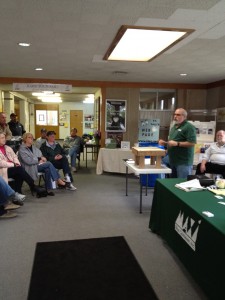
Rick talks to the attendees at St. Paul's Rain Barrel Workshop!
May 4, 5, and 6th found us at the Plymouth Green Street Fair. This is usually one of the better green events and this year’s did not disappoint. After gloomy weather on Friday, Saturday and Sunday were bright and sunny, bringing thousand of people to Downtown Plymouth. In the past two years, we sold out of rain barrels at the Plymouth Green Street Fair, so we made sure to have extras. Interestingly, while we sold more rain barrels then in years past, it was our compost tumbler that sold out. Another big hit was our rain barrel stands made from wood reclaimed from used wooden pallets. We also introduced RainSaucers and our up-cycled steel drum benches.
We had a wonderful time at all of these events interacting with people interested in rain water harvesting and protecting our environment. If you have an event our are interested in setting up a fundraiser for your non-profit group, feel fee to give us a call at 1-800-727-MAXI or contact me at rick@maxicontainer.com.
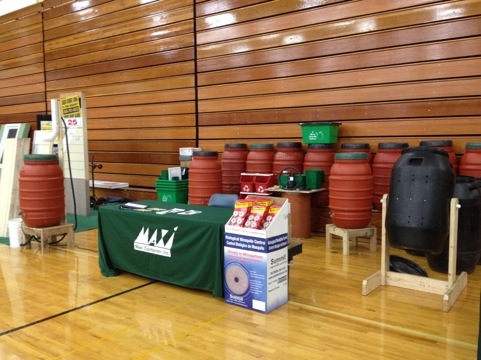
Our setup at Grosse Pointe Live Green Home Show

I had a great time on my birthday at the Plymouth Green Street Fair

Our RainSaucer Garden
Tags: events, Green, Green Fairs, grosse pointe, Plymouth, rain barrels, RainSaucers
Posted in Blog, Latest News | No Comments »
Saturday, March 24th, 2012

Last night, Anchor Bay Middle School hosted a green Science Night, and were invited to show our rain barrel and compost tumbler. When I arrived ( a little late ) the hallways where filled with kids from 6th, 7th, and 8th – quickly setup and started to engage in conversations with students and parents.
My colleague, Annette was also there to help explain the many benefits of rain water harvesting. Many had questions and we handed out flyers for our upcoming free event “Rain Barrels on the Riverfront” hosted by the Detroit RiverFront Conservancy and The Sierra Club. ( Download the flyer )
After about two hours the crowds slowed and we began to pack up, before I left they started the raffle. We donated a Rain Barrel to be raffled off, here is a pic. (I’m not sure who won it still though)
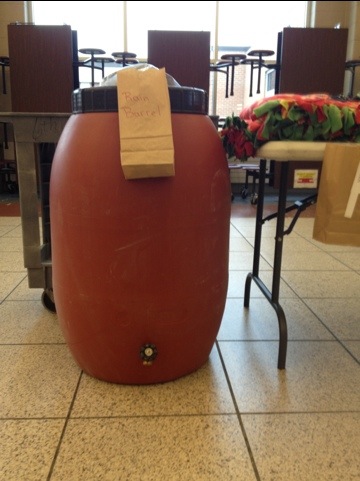
Overall, we had a wonderful evening and I would like to on behalf of Maxi formally thank Anchor Bay Middle School North for organizing the event and including us. Our friend from GreeningDetroit.com were there too… Checkout there website for more info and video from event here.
I also heard that yesterday Anchor Bay MS North received their official MI Green School Certification, congratulations!
If your school is having a green event like this please contact me at joshua@maxicontainer.com
Tags: Compost, Education, Green, Rain Barrel, schools
Posted in Blog, Latest News | No Comments »
Friday, March 9th, 2012
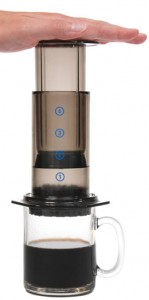
The AeroPress
My wife Gail and I are self proclaimed coffee snobs. We like our coffee strong, robust and fresh. We have been buying whole bean coffee and grinding our own beans since 1978, and have had every kind of coffee brewer, espresso maker and French Press you can imagine. My wife and I are now empty nesters. Our son Joshua is married with a family of his own. Our daughter Michelle is away at college. We no longer need to make a full pot of coffee every morning. But, we are strong believers in sustainability and recycling so we will never ever buy one of the fancy expensive single cup coffee makers that are so popular.
These one cup coffee machine, such as the Keurig and Tassimo, seem to have become ubiquitous. I see their little “k-cups” and coffee pods everywhere. Although expensive, many people have opted for the convenience offered by these single serving coffee systems. According to the Los Angeles Times, in the 12 months ending in November, nearly 46% of the dollars going toward the purchase of coffee or espresso makers went to single-serve machines. The L.A. times story reports that according to Keurig 13% of all US offices has one of their machines.
The problem with this is that single servings of anything, by definition, have more packaging and create more waste than buying the same product in bulk. In this case, the environmental impact is complicated by the difficulty in recycling the single serving k-cups and pods. Tim Wall at Discovery News points out that the k-cups are made of a plastic shell, lined with a paper filter and topped with aluminum. Individually, the components are recyclable, but put together they can only be trashed. What’s more, the compostable coffee grounds are trapped inside.
So how to make a single or double cup of really good coffee while staying true to our core values? The answer turned out to be a $30 little plastic coffee maker called the AeroPress. I had kept coming across references to it in different blogs but couldn’t find it in any local store. The reviews were simply amazing. As explained by Mike Crimmins in his Daily Shot of Coffee Blog, the Aeropress came from inventor Alan Adler, who is best known for his Aerobie flying ring and similar toys. He took a scientific approach to making coffee and came up with the Aeropress.
The Aeropress is a simple machine. According to Gizmag the AeroPress delivers the smoothest, richest, purest and fastest cup of coffee (under 30 seconds) you’re likely to find. The AeroPress can make up to four cups of great coffee at a time, much faster than my espresso machine or a single cup system. I have to agree and best of all, the only consumables used are the coffee grounds and the small paper filter, both of which are compostable.
Tags: Coffee, Green, Green LIving, Packaging, sustainable, waste
Posted in Blog, Latest News | No Comments »
Thursday, March 1st, 2012
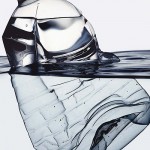
I have written in the past about my views on bottled water and the movement to ban it on several college campuses. Recently, Charles Fishman, an award winning investigative journalist and author of The Big Thirst posted a blog on National Geographic website that while pointing out the numerous problems and environmental impacts of bottled water went on to argue that:
“Banning bottled water doesn’t really teach anyone anything.”
His argument, which makes a lot of sense, is that banning bottled water sales on campus, while allowing the sale of soda and energy drinks is illogical. He points out that these products are 95% to 99% water and that, “It takes 2.5 liters of water to produce every liter of Coke products”.
Fishman points out the negative environmental impacts of bottled water, stating that “It takes a fleet equivalent to 40,000 18-wheelers just to deliver the bottled water Americans buy every week”. However, he questions whether this is any different than the fleets delivering caramel-colored, caffienated water in bottles?
Fishman is no stranger to the negative impacts of bottled water. I highly recommend his 2007 article, Message in a Bottle which explores the bottled water phenomenon in depth. In that article he determines that:
“Buying bottled water is a choice … and given the impact it has, the easy substitutes, and the thoughtless spending involved, it’s fair to ask whether it’s always a good choice.”
In my opinion, that question has been answered over and over. Due to its negative environmental impacts, bottled water is only a good choice where there is not access to safe reliable tap water. On most college campuses in the U.S. safe drinking water is readily available, as are reusable bottles.
USA Today states that according to the Association for the Advancement of Sustainability in Higher Education (AASHE), 14 colleges and universities in the United States and Canada have campus-wide bans, while another dozen or so have bans that cover a portion of campus. While these bans are a step in the right direction by creating awareness of the negative impacts of bottled water, by not addressing the environmental and health impacts of the remaining beverages, including soda and energy drinks, they fall far short of promoting an overall sustainable college environment.
However, recently the University of Vermont became one of the first universities in the U.S. to not only ban the sale of bottled water but to mandate that one-third of the beverages in its campus vending machines be healthy options. The policy also has the University changing its drinking fountains into bottle refilling stations so that students can use refillable bottles instead of using, and disposing, of plastic water bottles.
Wisebread.com has listed 22 reasons to stop drinking soda – Here are a few of my favorites:
- It may lead to diabetes and heart disease.
- Soda consumption is linked to osteoporosis.
- Drinking cola can increase your risk of kidney stones.
- It can take up to 132 gallons of water to produce a 2-liter bottle of soda.
- Be it glass, aluminum, or plastic, all bottles have their environmental costs.
- Transportation of soda pop requires a lot of fuel.
Sustainability has social, environmental and economic dimensions. Given the health and environmental impacts that soda has, the fact that the United States, with less than 5 percent of the world’s population, is the largest soda consumer and accounted for one third of total soda consumption in 1999, suggests that Fishman is correct that only banning water bottles on campus is not enough. To truly address the societal and environmental costs, our colleges and universities should, as did the University of Vermont, require the availability in vending machines, in dorms, food service on campus, healthier alternatives to soda.
Here is a very interesting infographic about why you should not drink bottled water …

Let me know what you think about bottled water and soda issues on campuses around the country, please leave a comment below!
Tags: Bottled Water, Campus, College, Green, sustainability, University, Water
Posted in Blog, Latest News | No Comments »
Monday, February 6th, 2012

Tis the season! [enter applause]
We’ll you may be thinking, “what season” or “aren’t the holiday’s over?”.
Yes! You are correct but the Green Season is just about to begin.
Maxi Container hasn’t just begun a transformation into a green enterprise, we are only embracing our most honored values and traditions and giving back to mother earth by selling our Terra Cotta Rain Barrel Kits. The product itself isn’t new but the attitude and determination as well as honest price and great results make our barrel better. It’s not the fanciest, it’s not the sleekest but it’s the best you will find for $60.
Trying to make your own barrel, that’s cool ask us for advice. We have plenty of barrels of all different colors, shapes, and sizes perfect for rain water collection. Please don’t just use a Rubbermaid garbage can made from low density polyethylene, that will eventually crack and bow when full. Don’t use a barrel you got for free from the car wash or any anonymous source. Get it from the barrel experts over at Maxi. We guarantee you get a previously used food grade barrel each and every time, it’s our profession and we take it to heart.
Preventing storm water runoff is only the begining, soon you will see our Rain Barrels everywhere ($40 shipping anywhere in the U.S.) but that’s not all… we teach workshops and make our weekends our work and go around Michigan’s best Green events too… lookout for a calendar widget on the sidebar coming soon.
For now I will leave you with this, a slide show of last years all star Maxi “Green Team” at our Rain Barrel events, enjoy!
View all of our photos from last years Green Events here.
Tags: 2012, events, Green, Green Fairs, Green LIving
Posted in Blog, Latest News | No Comments »
Monday, February 6th, 2012
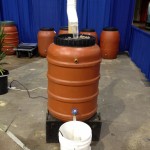
It hard to imagine in February that Spring, and our Rain Barrel Season, is right around the corner. We will be teaming up with the Sierra Club’s Great Lakes Program again this year to promote the use of rain barrels to help reduce Detroit’s combined sewage overflows and storm water pollution. This past weekend we had our first Live Green Fair of the season at Kellogg Arena in Battle Creek.
Last year, we sold 440 rain barrels and hope to better that mark this year. When talking to people about their rain barrels we tell them how quickly they will fill up in a good rain. In talking with Melissa Damaschke of Sierra Club’s Great Lakes Program we decided to attempt quantify the amount of rain water those 440 rain barrels could harvest in a year.
Being that I love researching an issue and spreadsheets, I immediately volunteered. Here is what I found.
The average rainfall in Detroit, MI is 32.89 inches. As reported in many news sources, 2011 was the wettest year in Detroit’s history with 47.7 inches of rainfall. (Climate Change anyone?) The average roof in the U.S. is 2400 square feet. To figure out how many gallons of water you can collect off your roof, just multiply the square footage of roof space by 0.6 gallons per square foot per inch of rain.
Plugging in this formula to the average yearly rainfall we get (2400 sq ft x .06) x 32.89 or 47,361.6 feet of space per house. Multiply this by our 440 rain barrels and in an average year we could help keep 20,839,104 gallons of water out of the storm sewers. Substituting the actual rainfall from 2011 of 47.7 inches and you get a total of 30,222,720 gallons of water saved.
Obviously, this example is based on every rain barrel we sold collecting every drop of rain from every home. In the real world, most people only hook the rain barrel up to one downspout. But even if only 1/4 of the rainwater was collected, that is over 7.5 million gallons of rain that we helped to collect for people to water their gardens, cars, etc. That is over 7.5 million gallons of rain water that did not make it’s way into the Detroit combined sewer system, did not help push raw sewage into the Detroit River and did not help cause one of the worst algae blooms in Lake Erie’s history.
It really is amazing how much good you can do with a simple thing like one of our Terra Cotta Rain Barrels.
Tags: conservation, Green, Rain Barrel, Water
Posted in Blog, Latest News | No Comments »
Wednesday, February 1st, 2012

One of the perks of owning your own business is that you can take time to be involved in your community. Today, I was involved in an event that proved the old saying, “Think globally, act locally.” Thanks to John Carlos and our friends at GreeningDetroit.com my son and co-worker Josh Rubin and I were Judges at the 2012 Michigan Regional Future City Competition hosted by The Engineering Society of Detroit (ESD). We helped determine the winner for a “special award” for the “Greenest City”. (Sponsored by GreeningDetroit.com)
The Future City Competition challenges students to design a city of the future and have fun doing it. The program is designed to promote technological literacy and engineering to sixth, seventh and eighth grade students. The idea is to foster an interest in math, science and engineering through hands-on, real world applications and help students better understand the practical applications of mathematical and scientific principles.
I met 6th, 7th and 8th graders from many different types of schools, from city schools to charter schools, and church schools to public schools. It was a very diverse group kids from all over the state. They all had one thing in common, enthusiasm. They spoke to myriad adults from many large and small business explaining in detail their model city. All of the designs were imaginative and addressed issues that we are all familiar with. Some had communication services that alerted paramedics in the event of a medical emergency. Others used maglev transportation systems, vertical farms, bio-domes, passive solar heating and living roofs among the many technologies. The students addressed where people would live, where they would work and how they would get there.
Our team of judges were looking for use of green products in building, sustainable development, greenery (parks and farms), how the city dealt with peak energy demands and the use of renewable energy. It was very difficult to determine the “Greenest City”, but after much discussion we gave our award to Birney K-8 School, Southfield, MI.
Birney’s entry had a recycling center, vertical farming, green roofs, geothermal, solar and piezoelectric energy. They used anaerobic digestion to break down wastes, recycled gray water, composted their food waste and, most dear to us at Maxi Container, used rain barrels to harvest rain water for irrigation.
As impressive as the students at Birney were, I was also impressed by St. Valantine’s who had movable sidewalks and a desalination plant. Hazel Park’s used electrochromic glass to control the light and heat in their buildings. Academy of the Sacred Heart used a combination of solar, wind and tidal power. The underwater turbines were bladeless so as not to harm sea life.
You can see a complete list of the winners here, but if you ask me, all of the schools were winners and so was our community as a whole.
Here is a slideshow from the event.[slickr-flickr search=sets type=galleria set=72157629134157333]
Tags: City, engineering, Green, schools
Posted in Blog, Latest News | No Comments »
Wednesday, January 11th, 2012
Continued from our Jan. 2012 eNewsletter.

Recently we invested in energy efficient lighting for our warehouse. Our new induction lighting provided by the Eco-Green-Energy. It uses half the energy as before, making it more cost effective and better choice for the environment.
One of the things I noticed when we purchased our new warehouse was the metal halide lighting in the warehouse. There were sixty 400 watt fixtures in the warehouse and while they offered plenty of light there were several problems with them.
1. Metal halide lights do not turn on right away. The warm up period can be as long as five minutes. In a warehouse full of pallets and drums, this means that you have to wait before you can walk around.
2.They are expensive to operate. On average a 400 watt metal halide costs $130.13 per year to operate. With 60 of them the average cost would be $7807.80. In our case, because of the number of hours we work, it was estimated that our cost would be $10,672.10 per year.
We turned to Sheldon Wardwell of Eco-Green. They proposed replacing the 60 400 W Metal Halide lights with 200 watt High Bay Induction lights. By using one-half the energy, we would cut that yearly cost in half, also reducing the CO2 and carbon emissions associated with electricity production. The new lights also have no warm up time and should last up to 100,000 hours.
The icing on the cake was that our local electric utility, DTE, had a Your Energy Savings Program that provided rebates to us that cut the cost of installation by 30%. This reduced our payback period for this project to only 2 years.
Next up, changing our office lighting from fluorescent to LED. The future is certainly looking bright.
Tags: DTE, Eco-Green-Energy, energy, fluorescent, Green, induction lighting, LED, Lighting, metal halide, metal halide lighting, Technology
Posted in Blog, Latest News | No Comments »
Thursday, January 5th, 2012
Here is a very interesting info-graphic which illustrates the new and volatile landscape that is high-tech corporate patent wars… Take a closer look, let me know what you think.

Via: Business Insurance Site
As a Creative Director, I use a lot of these patented devices and software, it is interesting to see how aggressive the patent war has become. I think that the future will prove to be clouded by these types of litigation and hopefully doesn’t slow innovation at the same time. As high-tech products make their way into the business world, increasing productivity and allowing employers to stay connected with their staff in many new ways, the changing landscape could become volatile. Let’s hope not.
Digital devices are not only leading to increase in productivity for many but also reducing the paper trail, traditionally associated with business which is a way to “Go Green” … every little bit counts!
Tags: Apple, device, Google, Green, HTC, IBM, law, Microsoft, Patent, patents, software, Tech, Technology, US
Posted in Blog, Latest News | No Comments »
Wednesday, December 7th, 2011

Charlie Rubin started reconditioning wooden barrels over 100 years ago. Max Rubin started reconditioning steel drums over 60 years ago. Maxi Container has been reconditioning and recycling industrial packaging since 1980. We didn’t know then that we were “green”. We thought that it made sense to reuse an expensive container over and over. Reuse wasn’t a choice made to save resources, it was an economic necessity during the Great Depression and WWII. Even as we became a disposable society, Maxi Container resisted the pressure to sell “one and done” thin steel drums. We often joke that we are in an industry that people do not know exists and, if they do, do not realize how committed to reuse and sustainability we are as a company and an industry.
Imagine my surprise when reading an article at the Smithsonian website about a new concrete that I learned:
- Last year, the world produced 3.6 billion tons of cement—the mineral mixture that solidifies into concrete when added to water, sand and other materials. Globally, the only substance people use more of than concrete, in total volume, is water
- The recipe for making cement calls for heating limestone, which requires fossil fuels.
- When heated, limestone sends carbon dioxide gas wafting into the atmosphere, where it traps heat, contributing to global warming.
- Cement production is responsible for 5 percent of the world’s human-produced carbon dioxide emissions.
- Typically, a cement factory produces nearly a ton of carbon dioxide for every ton of cement.
In steps Nikolaos Vlasopoulos, an environmental engineer at Imperial College in London who worked summers measuring carbon dioxide levels with his uncle at a cement plant in Greece. He has developed a cement that is made with magnesium oxide and magnesium carbonates. These are made by adding carbon dioxide to his mixture. The cement, in some scenarios, is not just carbon neutral—it’s carbon negative. For every ton of Vlasopoulos’ cement produced, one-tenth of a ton of carbon dioxide could be absorbed.
There are several other companies trying to make a better, more eco-friendly, cement. Stanford Professor Brent Constantz along with venture capitalist Vinod Khosla have formed a company called Calera Corp. which has a pilot factory in Moss Landing, CA. Their process harnesses carbon dioxide emitted from a power plant and mixes it with seawater or brine to create carbonates that are used to make cement. Calera says that for every ton of cement they make, they can sequester a half of ton of carbon dioxide.
Both the Calera and Vlasopoulos cement have an interesting characteristic in common. They are both white, while normal cement is gray. This means that you can add color to it and that builders, architects and artists can not only use it to make environmentally friendly buildings, but colorful ones as well.
Some of these new approaches to cement are already in use. On Interstate 35W, just east of Minneapolis, the St. Anthony Falls Bridge carries 10 lanes of traffic on box girders borne by massive arching piers, which are supported, in turn, by footings and deep pilings. The bridge, built to replace one that collapsed in 2007, uses components made from different concrete mixes. The mix used in the wavy sculptures at both ends of the bridge is designed to stay gleaming white by scrubbing stain-causing pollutants from the air.
Just like people don’t realize how sustainable industrial packaging can be, who knew that cement could become a green technology? Have you heard of a surprising green product or technology? We would love to hear from you, please leave your response in the comments below.
Tags: Carbon, Carbon Dioxide, Concrete, eco-friendly, environment, Greece, Green, London, sustainability
Posted in Blog, Latest News | 1 Comment »
Monday, November 21st, 2011
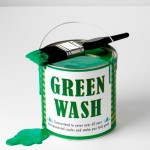
Today, when you go to almost any store, you will find some trace of the “green thing”. You may find energy efficient light bulbs at Home Depot, rechargeable batteries being pushed at stores like Best Buy, or the lack of plastic shopping bags at Costco. These are all signs of a changing environment for the average consumer.
Let’s go back a decade, did you see all of these things? I didn’t, but then again I wasn’t looking very hard back then. The real change is in the hearts of the consumer, but why is being green better? Is it cheaper, not always. Then how is it more beneficial to me? Maybe it is because it is more sustainable? YES!
Okay, now for the next part: what does sustainability mean? It means a lot, literally… from the way the resources for a product were made or obtained, down to the ingredients, manufacturing and distributing process, even things like employees having benefits such as health insurance. Most people do not realize this. So who is responsible for correctly marketing that Green product on the shelf? Sadly there are not enough third parties concerned to monitor the accuracy of manufactures green claims, so plenty of products loosely or falsely advertised as being “green” get by.
After reading Wendy Knowlers Blog Consumer Watch article “Any idea how ‘green’ that product on the shelf is?” about the same subject, I realized that “are we really making informed choices?”
The answer is NO. We are easily persuaded by marketing techniques, leaving the resposibility on the company to correctly and truthfully market their products, which doesn’t always happen. Case-and-point; recently Fair Cape spokesman retorted after being question about whether their products are actually “Free Range”
“We did not call the milk ‘Free Range’, we called it ‘Fair Cape Free Range'” – That is, Fair Cape’s take on free range.
This is the type of attitude that gets consumers in trouble, this company is playing the system. They are capitalizing on a popular terminology that is equated with being sustainable, when in actually there is nothing sustainable about how they treat their cows. This is a prim example of GREEN WASHING.
We try our hardest at Maxi to correctly market our products and stray away from Green Washing techniques practiced by plenty of our competitors. We don’t confuse you with the terms “Recyclable” vs. “Made from Recycled Materials” we are straight shooters, the straightest that I know.
Whether it’s about how your food was brought to table or what was previously in your Rain Barrel, make sure that you aren’t being fooled into buying a product that isn’t truly green. Beware: it’s a buyers market with little responsibility for green washing, companies find ways to creatively brand and sell their products catered to what the buyers are looking for, regardless if they are 100% accurate claims. The weight is on your shoulders, I suggest you equip yourself with a mobile app call GoodGuide (they also have a website, for all of you not currently on the Smartphone bandwagon) to determine before you buy how Good that product really is. You just have to scan the bar-code and wait for the products score to appear. I hope you check it out.
What do you think about Green Washing, has it happened to you? Please comment below to strike up a conversation with us!
Tags: Android, App, business, Consumer, free range, GoodGuide, Green, Green Wash, Green Washing, iPhone, Marketing, Misleading, Popular, Products, Shopping, Smartphone, third-party
Posted in Blog, Latest News | No Comments »
Thursday, October 6th, 2011
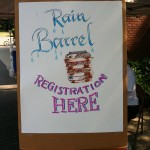
A few years ago, when we set out to get involved in making Rain Barrels and selling other Home and Garden products at Metro-Detroit Green Fairs, we never thought it would turn out so incredibly well. The community involvement with green fairs, charities, school and churches has helped shape our business, continuing over a hundred years of Rubin family involvement in the drum and barrel industry. Now, at Maxi, as the summer comes to a close, so does a chapter of our lives. The Green season is over, there no more events until next Spring/Summer. We all set our sights on the numerous things we have neglected due to the hustle and bustle of the season. We won’t be hibernating this winter, but a part of us will. The Green part.
I thoroughly enjoyed all of the events we were involved in (a list is provided at the end of this post). However, certain moments, or days, stand out when looking back from the corner of the autumn and winter seasons. I want to share my favorite “highlights” from this summer with all of you.
Two tents down! Currently, both of our tents need repair. One, we have no idea what happened to, and the other a storm almost swept away! At the St. Clair Shores Green Fair in the Park it was a beautiful day until warnings of a oncoming storm started to spread across the fair (since the Dream Cruise was happening on Woodward Ave. simultaneously, we just checked their twitter feed) Even though the vendors and patrons were advised to leave a little early in hopes of missing the brunt of the storm, we were among the last out of there, and our tent nearly didn’t make it out at all. I went to grab the truck for our final load of Rain Barrels, and when I arrived to our location I find my father (Richard) holding onto a tent that was in shambles. He looked like he was holding onto it for dear life, in high winds and heavy rain. This was a very intense end to a great event.
HOT, HOT, HOT! All of you remember that heat wave in June? Well we can’t forget it. We had three events planned almost simultaneously for that weekend of heat. Friday I spent in Armada while the rest of the Maxi staff was at the Ferndale Live Green Fair. I guess this is one time I lucked out, since at the Lavender Festival in Armada we had a location in the shade and the fair was on grass, not pavement. The staff at the Live Green Fair said it was sweltering hot as the intense sun reflected up from the ground. Also, the way the booths were set up didn’t allow a lot of airflow. On Sunday, I made my way to Ferndale, my father and I did the best we could, but I was definitely suffering during tear down, and was afraid I was going to pass out. My Dad had to stick me in the car with the AC on to get me to stop acting loopy. I am pretty sure I was a second away from heat stroke.
We enjoyed all of the events this year, these two weekends were exceptionally interesting, check out the list below for all of our events this year, and watch out for even more next year! Hope to see you next summer at some of our Green Events!
I tried to remember them all and hopefully, got them all of them here. Click on each to learn more. This list doesn’t include all of the Rain Barrel workshops we have done, just a few of them.
If you know of an event in Metro-Detroit (really anywhere in Michigan) that you would like us to bring our sustainable living setup including Rain Barrels, Composting, and Container Gardening, please let us know. Drop me an email at joshua@maxicontianer.com with the details.
Enjoy this slideshow of photos from our “Green Fairs” Collection of photoset’s on Flickr!
[slickr-flickr tag=”GreenFairs” type=”slideshow” captions=”on” delay=”3″]
Tags: Armada, Birmingham, Compost, compost tumbler, Composter, Composting, container gardening, earth day, East Lansing, Fair, Ferndale, Ferndale Perennial Sale, Garden, gardening, Grassroots, Great Lakes, Great Lakes Folk Festival, Green, Green Breeze, Green Fairs, Green LIving, home and garden, Live Green, local motion, Metro-Detroit, Michigan, Perennial, Plymouth, rain barrels, Rick Rubin, Rochester, Sierra Club, Sierra Club Great Lakes, St. Clair Shores, sustainability, Water
Posted in Blog, Latest News | No Comments »
Wednesday, September 7th, 2011
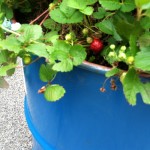
On August 31st, Compuware debuted its newest creation (and it’s not software) Lafayette Greens, an urban garden located at the old Lafayette building site, which was demolished in 2009. The community garden will provide all organic produce for Gleaners Community Food Bank (and if there is an over abundance of produce, it will go to the volunteers too!). The garden will be maintained almost entirely by a volunteer workforce. I was fortunate enough to join them for the grand opening celebration.
This initiative is run by Compuware employees Gwen Meyer (onsite manager) and Meg Heeres (project manager). We had the pleasure of meeting them during the development of the garden, consulting on the design types possible with our containers. They eventually had to resort to custom made beds for the majority of the garden, but still utilized our drums in the “Children’s Garden”. In this section our used juice drums were placed in a circular design which is lower to the ground so kids can interact with the plants better. It has a very “zen” feel to it.
The event was spectacular, samples of gourmet cuisine made from fruits and veggies grown in the garden were being passed out. Free drinks (non-alcoholic) and lively music was playing. The news obviously was informed about this event, I think I saw one person from every major local station there! This event was well planned. I enjoyed my afternoon there, though I mostly just hung out in the Children’s Garden where our containers where displayed.
They also are utilizing one of our compost tumblers, though I don’t think a single tumbler will be able to supply the entire gardens needs. The footprint of the garden is the entire corner, it’s pretty big. I urge any and everyone who is in the downtown Detroit area to go in and check it out!
We are so happy to be involved in the beautifying of Detroit with Compuware. At Maxi, we are dedicated to getting involved in our community and the amount of gardens going up in Detroit this year was amazing. We urge others to develop community gardens and work together to turn vacant lots into functional and beautiful gardens. This is the green movement and companies like Compuware and Maxi, and people like Gwen and Meg are what our city needs. Take a moment to check and see if there are any projects planned for your community.
Enjoy this slideshow of pictures from Compuware’s Lafayette Greens Community Garden. You can view these photos on our Flickr as well.
[slickr-flickr search=”sets” set=”72157627569688870″ type=”slideshow” captions=”on” delay=”3″]
Lafayette Greens is on Facebook!
Tags: 55 gallon, 55-gal, 55-gallon steel drum, 55-gallon steel drum planter, children, children's garden, Community, Community Garden, compost tumbler, Compuware, Container, Detroit, Food Bank, Garden, Gleaners Community Food Bank, Green, Greens, Lafayette, Lafayette Greens, Organic, Organic Produce, planter, Produce, Urban, Urban Garden, used containers
Posted in Blog, Latest News | 2 Comments »
Thursday, August 18th, 2011

Living in an apartment and condo does NOT mean you can’t garden. And people, I’m not talking about one or two hanging plants. I am talking about really gardening… fruits, veggies, flowers, and herbs. Right now I have tomatoes, potatoes, onions, corn, jalapeno and cayenne peppers, plus a herb garden and a few flowers for accent, all on my patio. You must be wondering just how I fit all that on my small 5′ x 10′ patio? Well let’s just say, very creatively. By utilizing hanging hooks on stands that fit four pails each, and two half pallets (I sawed one in half basically), I can make a varying array of configurations that are both beautiful and at the same time add a sense of privacy to our patio.
Another benefit of my container garden is the family activity it creates. My fifteen month old daughter grabs my hand and begs to be a part of the gardening experience. I supply her with her own little watering can and a plastic spade shovel to dig in the dirt with me. This is a family garden. It has become a central part of our family life. Whether it is the wife and I relaxing after the baby has gone to sleep, or working together to harvest some basil to make pesto for dinner, it is enjoyable and bring us even closer together. If you live in a apartment or condo and think that gardening is just too much to handle, reconsider. Give it try. We have previously used food grade 5-gallon pails perfect for starting your very own garden. Please email me at joshua@maxicontainer.com for a free consultation. We can design your pails to fit the types of plants you want to grow. We have three styles right now for our 5-gallon pails, they are:
- Traditional planter
- Hanging tomato planter
- Pepper / strawberry planter (Can hold up to 6 plants)
*can easily be made into a self-watering planter
We also have experimented with our 30-gallon plastic barrels, turning one into a strawberry planter. We cut a plastic juice drum in half, attached wheels and handles to make a movable planter perfect for all types of plants. Like I was saying before, the possibilities with container gardening are endless. You only will be limited by your own creativity. So, what are your waiting for? Try it now. Give us a call today and get the low-down on what you’ll need to get started. And please, if you don’t get your container from us just make sure the containers are food-grade. Ask what the previous contents where. If it was something questionable, DO NOT USE IT. If it had food in it before, then its fine. It’s better to ask then to just say “ohhh it’s fine because it was free.” You will be growing and eating food from that container. Plastic absorbs some of its previous contents; there is no way around that, it is in the material’s nature. So any reconditioned or used plastic barrel, is not always safe for growing plants. Hope this information helps get you started container gardening. Here is some photos from our Flickr photoset “Container Gardening”.
[slickr-flickr search=”sets” set=”72157627032002916″ items=”20″ type=”slideshow” delay=”3″ captions=”on”]
Tags: 5-gallon pails, apartment, condo, Container, container gardening, food-grade, gardening, Green, pails, Previously used, sustainability
Posted in Blog, Latest News | No Comments »
Tuesday, August 2nd, 2011

This summer has been a busy one for us here at Maxi Container, Inc. Our Rain Barrels, which started as a tiny side-project for us, have turned into an entire Home & Garden product line. This line now includes Rain Barrels, Compost Tumblers, Compost Tea Kits and our newest product…(drum roll please) container gardening! We are currently testing out various container gardening designs for our pails and barrels. Expect to see them soon on our website. You may have already seen some of our container gardening items at one of the many Green Events we have been at this year. If you haven’t already please check out our Flickr “Container Gardening” photo set here.
At Maxi, our passion does not end with our workday. We have a love for being involved in our community. To that end, we work with schools, churches and other non-profits such as the Sierra Club Great Lakes Program to help spread the word about water conservation, composting and reuse.
From rain barrels to rain gardens, from composting basics to compost tea, we are involved in every step of our products design and manufacture. (Technically speaking, its re-manufacture, since our Home & Garden products are made from used food grade containers). Nothing goes unnoticed and if anyone has a question or complaint (no matter how small), we make sure to take care of it. That’s what you get when you choose MAXI.
Now, with that all being said, as one of my favorite frogs once said, “It ain’t easy being GREEN.” Our Home & Garden line has turned into a full-time job. Our Twitter is full of eco-friendly tweeters and gardeners. Sometimes we participate in green fairs and community events two to three weekends in a row. When you add in the time it takes to get ready for these events, you can see how hard we are working to promote our core concepts of sustainability, reuse and conservation. Why do we do it? Just take a look at this past month of July…
We arranged to be involved in three different events one weekend and had another event the next weekend. Within nine days, we had four events. If you asked me last year at this time if we would be at that many events, I would of simply answered “not possible”. Now my attitude is different and the sky is the limit.
The first event was the Ferndale Live Green Fair. While in its second year, it is still in its infancy. Last year the Live Green Fair was part of the Funky Ferndale Art Fair and it had only eight or so vendors. However, it was a great success. This year it became a standalone with over 80 GREEN vendors. The event was beautiful, with fun for all ages. The only downside was the heat. This past July turned out to be one of the hottest on record for metro Detroit, and the Live Green Fair happened to be smack dab in the middle of one of our biggest heat waves. I applaud any of the people who made it out to the Ferndale Live Green Fair. We thank you for braving the high temperatures! This green fair is by far the truest green event (the creators are extremely green guys!) and it has a lot of potential. Let’s just hope that next year there is better weather!
Our second event was the Lavender Festival in Armada, MI, hosted at Blake’s Cider Mill. Though not a “Green” fair per say, the event had many green vendors, organics for your garden, artwork made from reused materials and of course, lots and lots of lavender! There was also an education tent that had a workshop every hour. I taught a workshop on Friday that was very successful and had a great time interacting with interested gardeners. We had a great time here and hope to come back again! Thank you to Jennifer Vasich, who created the event and who asked us to be a part of it for the first time.
Our third event of the weekend was part of Farmington’s Founders Festival. We had a very successful workshop with the Salem United Church of Christ in Downtown Farmington. Read the full article here.
The next weekend, we took part in Birmingham’s Green Breeze on the streets of Old Woodward. Richard Rubin (my father) and I set out to see what all of the local Birmingham residents were up to. The turnout for this event hasn’t been as great as we would like, but the people we meet at it seem to be committed to the same values as we are at Maxi. I had some great conversations, met some really exciting and cool new people, and sold a few rain barrels. We also saw many familiar faces. Overall, it was a good weekend and a relaxing final show for our busy two weeks.
Why have I gone into such great detail to illustrate what we did this summer? Some of you may ask why do these Industrial Packaging guys give up their hard-earned weekends? We do it because here at Maxi we believe in our community and in empowering people through education about reuse and sustainability. Stop and think about it. If more businesses operated like Maxi, wouldn’t the world be a better place? The bottom-line is not always about making a dollar. Sometimes it’s just simply about making an impact.
Hope to see you at one of our upcoming green events… check our Facebook or Follow us on Twitter for up to date news on where we will be!
Tags: Armada, Barrels, Birmingham, Compost, Compost Tea, container gardening, Fairs, Farmington, Ferndale, Green, Green Breeze, Lavender Festival, Live Green Fair, rain barrels, Salem Church, Workshops
Posted in Blog, Latest News | No Comments »
Thursday, July 21st, 2011
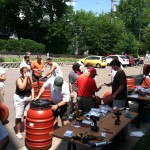
Here at Maxi Container we have many sayings, some are left over from our founder, Max Rubin. Not all are polite or politically correct, but are distillations of business wisdom passed from generation to generation of the Rubin family. The saying that we use the most is our slogan and core value MAXI means the MOST in SERVICE and QUALITY. We use this as a shorthand for our commitment to customer service before and after each sale. Another one of our core values is being committed to reuse and recycling. Many of the containers we sell are reconditioned. They have been previously used for the transport of various industrial products, collected, cleaned in an environmentally sustainable manner, and then re-certified for reuse. For the past few years we have been up-cycling (re-purposing) food-grade containers as rain barrels and compost tumblers. We have attended numerous green fairs, worked closely with schools and community-based organizations such as the Sierra Club, to promote the use of rain barrels, composting, reuse and recycling.
This leads us to another one of our sayings and core values. Today it simply is not enough to “talk-the-talk” about green products, or your commitment to reuse and recycling. You have to literally “walk-the-walk” to prove to your commitment to the public. Here at Maxi, we pride ourselves on actually following through and “walkin’ the walk”. Our products are often reused or reconditioned, we recycle our office paper and run our trucks on bio-diesel. This past weekend we took our commitment to being green one step farther, farther then we ever have in the past. Maxi was involved in three community events this past weekend, simultaneously! Most of this came about due to the hard work of our Creative Director, Joshua Rubin. This past weekend we were exhibitors at both the Lavender Festival in Armada, MI and the Live Green Fair in Ferndale, MI. We also worked with the Salem United Church of Christ in Farmington, MI to hold a rain barrel workshop were people could learn how to build their own rain barrel. Joshua was the principal speaker and trainer at both Armada and Farmington. He then worked with me in Ferndale on Sunday, in 90+ degree heat.
The result was a wonderful weekend where over 120 rain barrels found new homes. I am very proud of my son Joshua Rubin for his commitment to our core beliefs of reducing our impact on the environment by “Walkin the Walk” and being GREEN.
Tags: Fair, Green, Green Fairs, Joshua Rubin, Rain Barrel, rain barrels, Sierra Club, Workshop
Posted in Blog, Latest News | No Comments »
Wednesday, May 18th, 2011
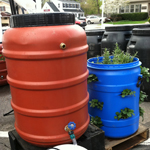
Maxi Container kicked of the spring season this year with a busy schedule. We participated in Green Fairs in Grosse Pointe, Plymouth, and Rochester. Community based events like these are a good way for us to meet the public and get feedback on our products, while educating people about water conservation, composting and container gardening. This past year we have redesigned our home and garden products, added new ones, and increased our commitment to green living by getting as heavily involved in these type of events.
Local Motion Green hosted an Earth Day Celebration on April 30. This was the first time Maxi had gone to Grosse Pointe Farms, and the response was tremendous. We had a great time talking to people who were excited about gardening and sustainability. The atmosphere was excellent with live music and events for kids too! Maxi also donated fiber drums to be used as recycling bins at Grosse Pointe Academy. You can read the whole article here.
The next weekend was the Plymouth Green Street Fair, May 6, 7, 8. Last year this was a great weekend, full of fun and friends. (Joshua and Richard are from nearby Farmington Hills) This year it was nothing less. Maxi was met with huge response on our Rain Barrels. We sold out! It was a fun filled weekend, which included a musical performance from American Idol runner-up Crystal Bowersox. They dyed the fountain green and even had a FLASHMOB (public choreographed dance) randomly in the center of downtown. Overall we had a wonderful time in Plymouth. (It helped that our tent was across from the amazing Plymouth Coffee Bean.) To view pictures from the event click here.
Last weekend (May 13, 14, 15) was the Rochester Green Living Festival, which has a strong reputation as being one of the premier green fairs in Metro-Detroit. They provide a rich experience, full of activities, entertainment and green vendors. There is something for everybody. The festival started as an Earth Day Expo and has grown significantly over the past few years. Unfortunately, this year was plagued with bad weather. On and off showers on Saturday detoured some, but we still did well. Sunday was a wash out, too cold for most to want to leave the house, with almost no attendees. Maxi still enjoyed being in Rochester for the first time, meeting all of the eco-conscious people looking for ways to reduce their carbon footprint and live a more sustainable life. Thank you Rochester and we hope for better weather next year!
Our upcoming events are the Ferndale Live Green Fair July 15-17, which takes place in Downtown Ferndale (9 mile and Woodward Ave.). The same weekend, on Saturday July 16, our very own Joshua Rubin will be in Armada, MI at the Lavender Festival, giving a Rain Barrel workshop/class. Maxi will also be at Birmingham’s Green Breeze on July 23, on Old Woodward between Maple and Brown Street. Please come out and join us at these GREEN events!
Tags: 2011, Birmingham, compost tumbler, Contianer Gardening, Crystal Bowersox, earth day, events, Ferndale, Green, Green Breeze, Green Fair, Grosse Pointe Academy, Grosse Pointe Farms, Joshua Rubin, July, Live Green, Live Green Fair, local motion, Local Motion Green, Metro-Detroit, Plymouth, rain barrels
Posted in Blog, Latest News | No Comments »
Saturday, April 30th, 2011
Having a great time at Local Motion’s Earth Day Fair! Lots of cool green vendors and awesome people celebrating earth month. Shout out to the Sierra Club, Greening Detroit, and The Greening of Detroit as well. GREEN EVERYTHING!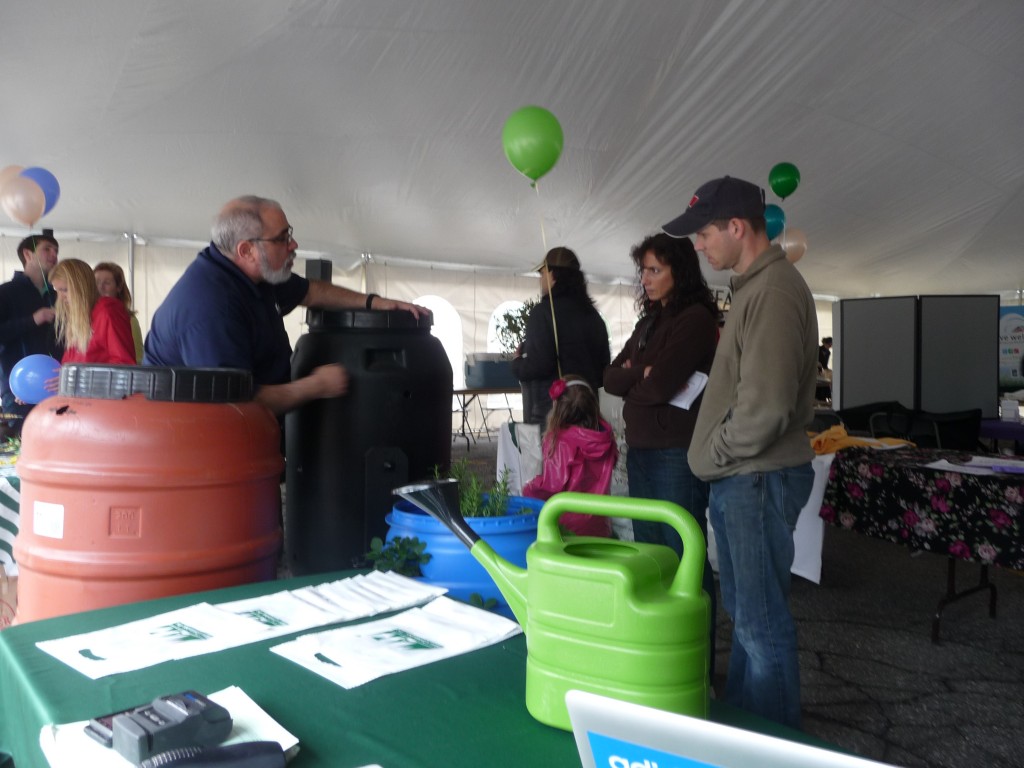
Tags: Detroit, earth day, Fair, Green, greening, Greening Detroit, grosse pointe, local motion, Sierra Club
Posted in Latest News | No Comments »
Monday, April 4th, 2011

Wednesday, March 30 I headed out to Warren, MI to check out their “All Things Green” expo. The event took place at the IBEW NECA Electrical Industry Training Center I was excited to take part in this event, though only as an attendee. Maxi normally has a booth/table at these type of events (selling our Home & Garden products) but I went to this with the intention to learn, not sell. I was pleasantly greeted when I walked in, next they handed me a name-tag and explained the layout and schedule. I quickly did a once around briefly checking out the displays/exhibits and trying to spot anyone I knew. After saying hello to Greening Detroit and MI Clean Energy I went into the conference room to sit in on the lectures.
First we were exposed to the ins and outs of Electronic Vehicles (EVs), they even had a charge station in the parking lot! Both residential, like the Chevy Volt or commercial use of EVs, such as Staples and FedEx which are currently switching thousands of their delivery trucks to electric power was discussed in detail. It was an eye opening experience, I learned about the new infrastructure developing to support of EVs. Here at Maxi we are conscious of our carbon footprint and currently utilize Bio-Diesel for our fleet but are looking for even more efficient alternative energy ideas for the future.
Next we learned about how one car dealership, Roy O’Brien adopted Solar and Geo-thermal energy and eliminated their utility bill completely! There are plenty of tax incentives and rebates from DTE for installing such systems. (Over time the systems will pay for themselves and eventually start saving you money) I have read about the residential greening of homes. (Ann Arbor is home to the nation’s oldest net-zero home.) but hearing about how one business made alternative energy work for them was very inspiring.
Between topics I walked around the displays set up throughout the building. There were some really interesting displays, two in particular that caught my eye were the EcoGreen display and the Chevy Volt. (below are photos) I learned a lot and want to officially thank Macomb County for putting on this event. I will leave you with my favorite quote of the event, from Mike O’Brien of Roy O’Brien Ford when explaining the beauty of having no energy bills anymore, “We’re tapping mother nature for free!”
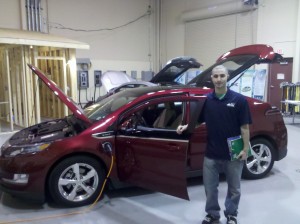
I checked out the new Chevy Volt, whoa what an awesome car!
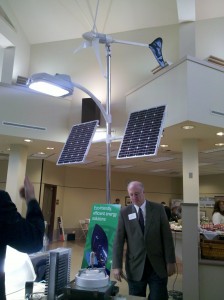
EcoGreen Light powered by solar panels and wind turbine
For another great article about the event please check out CBS Detroit’s article here.
Tags: Biodiesel, Chevy Volt, expo, FedEx, Green, Macomb County Michigan, Sustainable energy
Posted in Blog, Latest News | No Comments »
Friday, April 1st, 2011
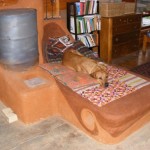
Maxi Container received an inquiry about a new 30-gallon steel drum and when we found out what it would be used for our interest grew. Steve Quinlan, the Director of Institutional Advancement for Advanced Technology Academy in Dearborn explained that a senior class of students taking the course Sustainable Energy II would build the heater. A Rocket Heater, otherwise called a Rocket Stove or Rocket Mass Heater, combines the air-intake with the fuel-feed slot in an opening terminated by the combustion chamber, which connects to a chimney and also a heat exchanger. Simply put, a rocket stove has a fuel magazine but primarily works like a wood burning stove which uses the exhaust to heat a adobe clay housing. They are simple to build and yield high combustion efficiency, all while channeling the heat into a specific (small) area. The design of stove means it uses half as much fuel as an open fire and can also use smaller diameter wood even twigs. The stove is insulated and raised from the floor which reduces the danger of children burning themselves.Some uses for a a rocket heater are:
- Cooking (mostly third-world countries)
- Space heater
- Water heater
Advanced Tech is one of Michigan’s green schools, (see our article about Michigan’s program for schools to earn different stewardship levels for completing green activities here.) and they are also a charter school.
After working out the details we setup a meeting on Monday March 21 at 1:30 PM where I (Joshua Rubin, Creative Director of Maxi) would drop off the drum and take a look at what is going on over at Advanced Tech.
Maxi wants to encourage other schools to contact us with any “green” projects or initiatives. From recycling in the classroom (see our Oprep article) to energy efficient rocket heaters seen here, we love to help schools. If we want to help reduce the next generations carbon footprint, we have to teach them early on to reduce, reuse, recycle, buy recycled products and safely dispose of their hazardous waste.
Thank you Advanced Tech for choosing Maxi, we wish you the best with your rocket heater project. Looking forward to seeing the pictures of the completed heater.

Sustainable Energy II Class with Joshua Rubin (Creative Director) and their new steel 30-gal drum.
For more information about Advanced Technology Academy and their programs please visit their website or send Steve Quinlan an email.
Tags: 30-gal, advanced technology academy, dearborn, energy, Green, green schools, Michigan, rocket heater, rocket stove, schools, Steel Drums, sustainability
Posted in Blog, Latest News | No Comments »


